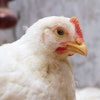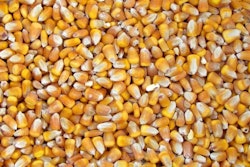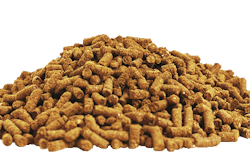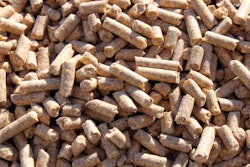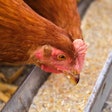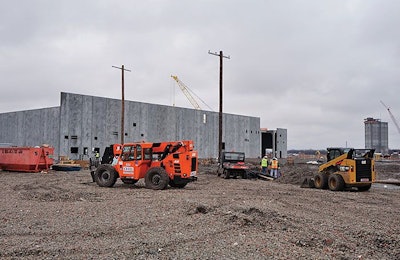
In Fremont, Nebraska, far from the traditional broiler belt of the Southeast and Atlantic states, a massive new poultry complex is rising. By late 2019, the estimated $400 million operation – complete with a feed mill, hatchery and processing plant – will be processing more than 2 million chickens a week.
The new poultry enterprise is run by Lincoln Premium Poultry (LPP) – a company owned in part by Costco Wholesale Corp. Walt Shafer, chief operating officer for LPP, said the chickens processed at the plant will provide about 40 percent of the Issaquah, Washington, retailer’s fresh chicken meat.
The business relationship with Costco
Shafer said LPP's role is to, essentially, operate and manage the asset and the business on Costco’s behalf. Costco is LPP’s customer, he said, and the majority of the products will go to Costco depots and warehouses.
“Lincoln Premium Poultry is a company created for Costco in collaboration with Costco,” Jessica Kolterman, a spokeswoman for LPP, said. “Our company reflects the values of Costco, and we are excited to partner with them in developing a fantastic product for Costco's members.”
However, the operation will not supply all of Costco’s chicken and it will still have other suppliers, Shafer said. This plant will process birds at 6 pounds, 4 ounces live weight to provide the specific size, weight and price Costco wants.
When asked if the project is a prototype for future facilities supplying Costco, Shafer replied: “Who knows.”
“My goal is to make this successful,” he said. “If we’re successful, which I know we will be, I think it will throw the subject up for debate in the future.”
Why Nebraska?
Shafer said the site works because of its location in the country as well as the ready supply of grains and potential growers.
Fremont’s central location in the continent and its ability to supply depots around the country works for Costco. In the beginning, Shafer said most of the product will supply locations in the western U.S. Also beneficial for logistics, and unlike operations in the South and on the Atlantic coast, corn and soybeans for the estimated 500 chicken houses needed to supply the plant will come directly from the state.
Although the state lacks a tradition of growing poultry, Doug Oertwich, a farmer from near Pilger, Nebraska, who’ll be running a breeder operation for LPP, said the prospect of raising birds is appealing to the state’s crop farmers.
Raising chickens creates an opportunity for farmers to bring in more, diversified income and generate paying work for family who would otherwise leave the farm. Doug Oertwich said his own son, Nicholas Oertwich, is coming back home to raise birds with him. Crop farmers also relish the prospect of creating their own, organic fertilizer and spreading it on their crops.
Training the farmers
While Nebraska is known for a tradition of crop farming and cattle ranching, its farmers are unfamiliar with raising chickens. LPP was tasked with both recruiting farmers from the surrounding region and training them in husbandry.
Oertwich served on an advisory board formed to recruit potential growers and help LPP and Costco understand the nuances of working in the state. After years of work, LPP recruited 125 farmers to put up chicken houses and grow birds on contract.
To train the new farmers, LPP is working with Auburn University to offer grower seminars on key concepts like house ventilation and animal husbandry. In the near future, a model chicken house will be built near the processing plant in Fremont. Shafer said it will host classes on growing in a working classroom featuring the exact same equipment growers will use.
The integrator relationship
As in a traditional vertically integrated poultry company, LPP will supply the feed and the animals as well as the building requirements for the poultry houses. The growers, working on a 15-year contract, are responsible for building the houses, raising the animals and supplying labor. In total, the growers will be investing about $300 million to finance construction of new houses.
LPP contracted with QC Supply, based in Schuyler, Nebraska, to serve as the general contractor for broiler house construction. QC is coordinating construction in collaboration with the growers. All houses will be identical and feature a state-of-the-art design and the latest growing equipment. The grower's compensation contract is inspired by a guaranteed base-pay concept. This way, the contract can reward above-average performance without punishing below-average performance, Shafer said.
Shafer said he’s already hired a complex manager, live production manager, breeder manager and veterinarian. LPP is expecting to benefit from working with new equipment and housing and employing growers newly trained in modern techniques and management.
Raising birds better than the rest
Shafer said all birds will be raised antibiotic-free and Costco will require regular third-party audits on both biosecurity practices and animal welfare. He said it’s uncertain if the company will sign onto any type of animal welfare standards. However, the company requires LPP “to be better than the rest” and birds will be raised at a stocking density lower than the industry average, he said.
The houses will be solid side wall and utilize tunnel ventilation with cool cells, and birds will be raised on cottonwood bedding. Breeder growers will clean out their litter once a year. Broiler growers will compost their litter in the house using a windrowing technique after each flock.
Oertwich said even though it is not required by the state, LPP and its growers will follow a nutrient management plan – based on plans used in the Chesapeake Bay watershed – to assess and mitigate the environmental impact of spreading manure on their fields.
Catching and transportation
LPP will use an automated catching machine – a CMC Industries Apollo model – which stores birds in drawer modules. The system doesn’t require any physical handling of the birds, which reduces the risk of injury to both the birds and the workers, Schafer said.
Transport trailers will feature curtain side walls. They use a solid, ventilated top with tarps or curtains covering the sides and back of the trailer. This prevents dust and feathers from exiting the trailer during transport and protects the birds from exposure.
At the plant, the birds will be kept indoors in an automatic lairage system capable of holding up to 12 tractor trailer loads of birds, or about 72,000 animals. This facility will calm the birds and warm if they are cold or cool if they are hot. After the truck is unloaded, it will be washed and completely sanitized. Used modules will be washed and sanitized, too.
The individual drawers and modules will be removed and placed directly into a controlled atmosphere stunning (CAS) system manufactured by Marel. After stunning, birds will be removed from the drawers and hung directly on a processing line. There will be no dumping, Shafer said, to the benefit of both the animal and the live hangers.
The processing facility
In total, LPP’s Fremont complex will contain a 400,000-square-foot processing plant, a 95,000-square-foot hatchery and a feed mill capable of holding five days’ worth of finished feed, or 15,000 metric tons. The feed mill should be operational by the end of 2018 and feeding should start in early 2019. The hatchery should be complete in the spring of 2019 so birds can be placed by June 2019.
Birds are expected to start running through the plant in September 2019. After about 45 weeks, the plant should be processing more than 2 million birds a week. It’s expected to employ about 1,000.
The facility will be one of a handful in the U.S. using an air-chilling system after plucking and evisceration. Shafer said about 80 percent of the equipment in the plant will be made by Marel.
Labor and automation
Labor, Shafer said, will be the most critical issue at the plant. As a hedge against challenging labor markets, LPP is employing high-speed, automated machinery in every step of the process. Robotics will also be used to package products.
“The list goes on and on, everything from automatic label application to palletization to even the deboning,” Shafer said.
Shafer said automation will help reduce the need for workers – he cited automated deboning as requiring 100 fewer workers than manual, as an example – but it will require more workers with higher educational and mechanical expertise.
The labor market is tight in the region, so LPP is partnering with recruiters to find unemployed and underemployed workers in western Omaha and the area surrounding Fremont. The conversation on attracting, employing and housing poultry plant workers is ongoing, he said.
$400 million: The estimated total cost of the new poultry complex in Fremont, Nebraska.
$300 million: The amount invested by the 125 contract growers who’ll build a total of 500 broiler houses to supply the plant.
2 million: The number of chickens expected to be processed weekly once the plant reaches full capacity.
$1.2 billion: The estimated economic impact in Nebraska from the installation of the new poultry operation.

